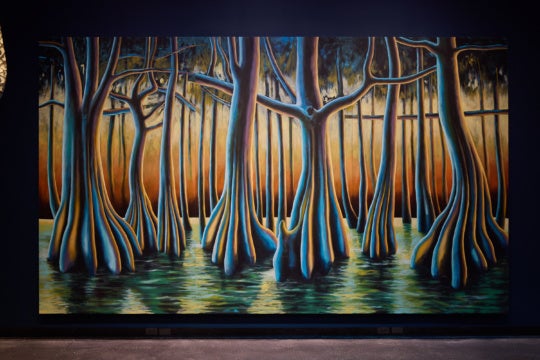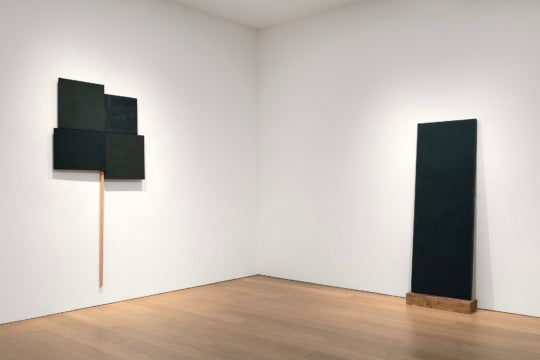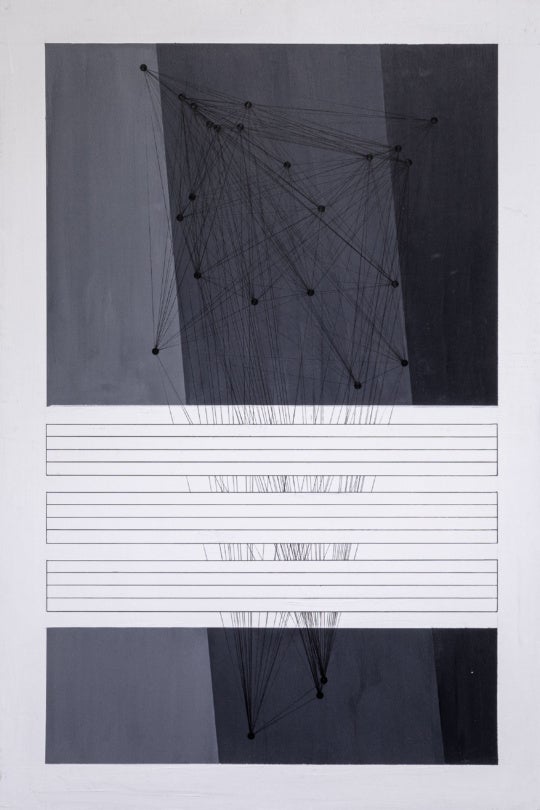
Hamlett Dobbins’s new exhibition at David Lusk Gallery in Nashville, “I Will Have To Tell You Everything,” is a perfectly titled show of about a dozen paintings that resist specific interpretations while also demonstrating Dobbins’s extraordinary technical ability as a non-figurative painter. Outside of reading the artist’s statement, it’s difficult to discern any underlying narratives or themes beyond these works’ gorgeous formal elements.
Dobbins’s paints are applied in the thinnest layers–the complexity of his lines, shapes, and designs all clash and combine on the shallowest of surfaces. In these works, various patterns and forms push themselves forward to capture the viewer’s attention before other elements overtake them. There is little accounting for positive and negative space, so there’s mostly no consistent depth to be perceived in these shifting works. The paintings in “I Will Have to Tell You Everything” possess insistent presences—they pulse before your eyes in a state of constant becoming.

My first reaction to this exhibition was just an attempt to distinguish the various visual textures in play: zigzags, checks, stripes, jagged triangles, organic spiderlike forms, dashes, colorful circles, grids, and even a few numbers. It’s important to see a show like this in a gallery as spacious as David Lusk. These are different paintings from thirty feet away than they are from three, but they are complex, energetic displays at every scale. You could spend a long time standing very close to these works, discovering endless nuances of pattern and gesture, color and texture, in only a few square inches.
For a show that plays its intentions close to the vest, it’s not surprising that Dobbins’s titles also offer next to nothing for the viewer to latch onto. All the works are untitled, with each piece dedicated to people who are only designated by their initials. According to the exhibition press release, the initials point to the people who are part of the experiences and emotional states Dobbins attempts to render in these works. In this sense “I Will Have to Tell You Everything” reads like a coded diary of intimate internal experiences, but scrawled in cyphers that look like gibberish, random markings, and designs with unknown purposes.

A few days after first seeing Dobbins’s show I realized that it reminded me of a video of Jacques Brel singing “Amsterdam.” My half-forgotten university French and Brel’s Belgian growl make much of this song about the sailors and prostitutes “[in] the port of Amsterdam” incomprehensible for me, much like a painting exhibition of untitled works purposely populated with highly personal symbols and signs. But Brel’s thrashing hair, his burning eyes, and the final, defiant shouting of the last lyric is unmistakable: this is a man who is laughing and crying, defiant and defeated, and he’s telling us about his pain. And when I look at the colorful, indecipherable compositions in “I Will Have to Tell You Everything,” it’s clear that Dobbins is doing the same.
“I Will Have to Tell You Everything” will be on view at David Lusk Gallery in Nashville through February 4.
Joe Nolan is a critic, columnist, and intermedia artist in Nashville. Find out more about his projects at www.joenolan.com.





